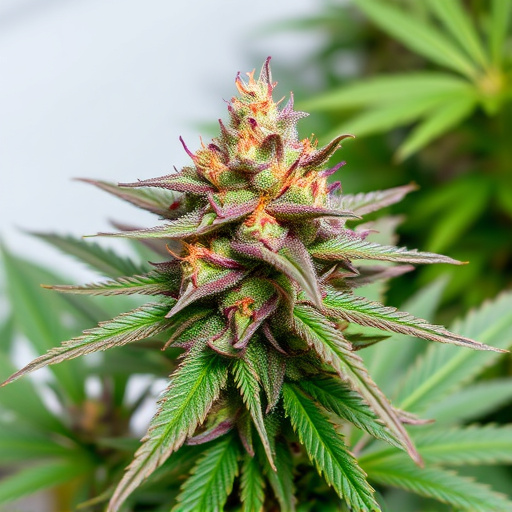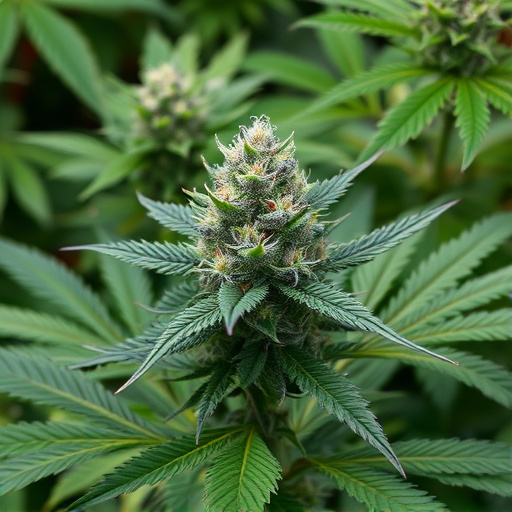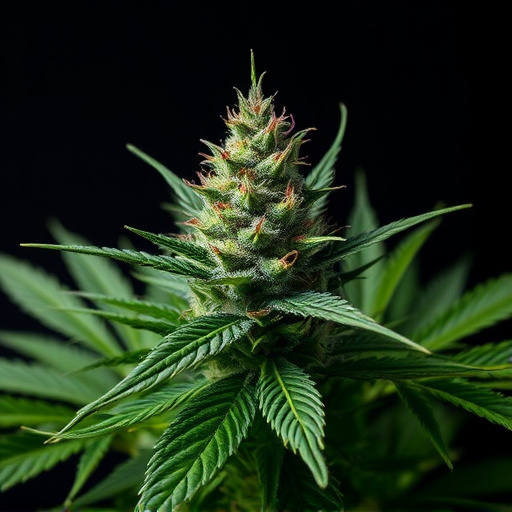The text explores the complex world of cannabis flower (Cannabis sativa) and its medical potential. Cannabis contains cannabinoids like THC and CBD, which interact with the endocannabinoid system. Different strain types (Indica, Sativa, hybrids) offer unique therapeutic effects for various conditions. Strains high in CBD aid anxiety and chronic pain, while those with THC assist severe nausea, appetite loss, or sleep disorders. Understanding these differences is vital for medical professionals and patients making treatment decisions. The legal landscape presents challenges and opportunities for research on specific cannabis strains legal in certain regions, fostering collaboration and advancing knowledge of ancient cannabis plants' modern medical applications.
Cannabis flower, with its diverse chemical composition, has gained significant attention for its potential medical applications. This natural compound offers a wide range of benefits, from managing pain and reducing inflammation to alleviating anxiety and improving sleep quality. Understanding the unique properties of different cannabis strains is crucial in tailoring treatments for specific medical conditions. Explore various types of cannabis strains and their therapeutic uses while navigating legal considerations and anticipating future research directions.
- Understanding Cannabis Flower and Its Medical Potential
- Types of Cannabis Strains for Specific Medical Conditions
- Navigating Legalities and Future Research Directions
Understanding Cannabis Flower and Its Medical Potential

Cannabis flower, derived from the plant Cannabis sativa, is a complex natural compound that has gained significant attention for its potential medical benefits. Beyond its recreational use, cannabis has shown promise in various therapeutic applications, making it a subject of intense scientific research and interest in the healthcare industry. The plant encompasses numerous chemical compounds known as cannabinoids, with two primary ones being THC (tetrahydrocannabinol) and CBD (cannabidiol). These cannabinoids interact with our body’s endocannabinoid system, which plays a role in regulating various physiological processes, including pain, mood, appetite, and memory.
Understanding the different types of cannabis strains is crucial when exploring its medical potential. Each strain offers unique combinations of cannabinoids and terpenes, contributing to distinct therapeutic effects. For instance, some strains are known for their higher CBD content, which may be beneficial for conditions like anxiety, epilepsy, and chronic pain without inducing psychoactive effects associated with THC. In contrast, other strains have elevated THC levels, potentially helping patients manage severe nausea, appetite loss, or sleep disorders. As research continues to uncover the multifaceted properties of cannabis, recognizing the specific attributes of different strains can empower medical professionals and patients alike to make informed decisions regarding treatment options.
Types of Cannabis Strains for Specific Medical Conditions

Cannabis has gained significant attention for its potential medical benefits, and one of the key factors in harnessing this potential is understanding different strains and their unique properties. Different types of cannabis strains offer varied effects, making them suitable for specific medical conditions. For instance, Indica strains are known for their relaxing and sedative qualities, which can be beneficial for managing pain, insomnia, and anxiety. Sativa strains, on the other hand, tend to provide a more uplifting and energizing effect, making them popular for treating depression, fatigue, and certain neurologic disorders.
Some hybrid strains combine the best of both Indica and Sativa, offering a balanced approach to treating various symptoms. For example, a balance between THC (tetrahydrocannabinol) and CBD (cannabidiol) levels can be optimal for managing chronic pain without causing excessive sedation. Specific strains like Blue Dream are renowned for their high THC content and pleasant, energizing effects, making them helpful for daytime use in treating conditions such as multiple sclerosis or depression. Conversely, strains like Granddaddy Purple are celebrated for their sedative properties, ideal for addressing insomnia or severe muscle spasms.
Navigating Legalities and Future Research Directions

Navigating the legal landscape surrounding cannabis is a complex task, as regulations vary widely between jurisdictions. This complexity presents both challenges and opportunities for medical research. Accessing and studying specific types of cannabis strains that are legal in certain regions can open doors to understanding their therapeutic potential. Future research should focus on unraveling the unique chemical compositions of various cannabis strains, as these differences may hold keys to treating diverse conditions.
The evolving nature of cannabis legislation encourages collaboration between scientists, policymakers, and industry leaders. By working together, they can ensure that research is conducted responsibly while advancing knowledge about this ancient plant’s modern medical applications. As more studies explore the benefits of different cannabis strains, we may see expanded treatment options for various diseases in the future.
The medical potential of cannabis flower is vast, with various types of cannabis strains offering targeted relief for specific conditions. As our understanding deepens, navigating legalities becomes crucial for future research and access to these therapeutic compounds. Exploring the unique properties of different strains holds promise for improving lives and expanding healthcare options, making cannabis a promising area of study in the medical world.














